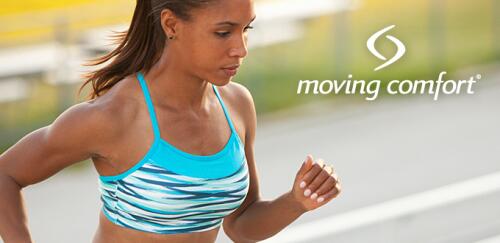There is plenty of helpful information found in the article below, however, it can be helpful to first view the "Bra Fit" page found here and come back to this page if you have any unanswered questions or simply want to know more.

BREAST PAIN & SPORTS BRAS: WHAT EVERY WOMAN SHOULD KNOW!
We spend a lot of time talking about running injuries and how to prevent them; shin splints, plantar fasciitis, knee pain, etc. One topic that is hardly ever touched upon, but perhaps the most important, is the potential soft tissue damage that female runners can cause in their breasts. Breast pain is one of the most common complaints of female runners. In a survey conducted at the 2012 London Marathon, 32% of women indicated they experience breast pain while running.
Most female runners wear a sports bra. The big question is, are you wearing the correct sports bra? 8 out of 10 women wear the wrong size sports bra. Are you one of them? Do you wear two bras to help decrease breast movement with exercise? Does your bra cause chafing? Today, I’m going to talk about what happens to the breast tissue during exercise and what you can do to help.
Anatomically, the breast has very little built in support. There are ligaments called Coopers ligaments that support the tissue, but other than that, there’s not much going on in terms of support. When running, uncontained breasts can oscillate up to 8 inches! This movement is not only up and down, it’s also side to side and front to back. It has been proven through motion studies that the breasts actually move in a figure 8 pattern during running. Ouch! Coopers ligaments can’t withstand all of this force by themselves, which is why a good sports bra is so important. One thing all ladies want to prevent as we get older is Coopers Droopers! That’s not a technical term, but you can figure out what it means!
The largest indicator of breast pain with exercise is cup size, with a larger cup being at higher risk for pain. After cup size, the next most influential factor in pain is breast movement. Studies have shown similar degrees of movement of the breast tissue with running paces from jogging to sprinting. It doesn’t matter how fast or slow you go, proper support is a must!
Not only are improperly supported breasts painful, it can also cause you to alter your bio-mechanics while running. Women will subconsciously alter their arm swing in order to prevent breast movement. This can cause other areas to become painful such as the shoulders, neck, and upper back. Not to mention, it really messes up your stride!
Is running bad for your breasts? It can be if you’re not properly supported, but, running has also been linked to decreased rates of breast cancer among other diseases. So keep running! Just make sure you have the proper support. Here are a few key points to look for in the fit of your sports bra:
- Band – should be snug, but not too tight. This is where you will get most of your support, so a good fit here is important. Your band shouldn’t cause chafing!
- Cup - breast tissue should be contained, not spilling out over the sides! If there is a lot of excess material, the cup is too large and you should go down in size.
- Underwire – if present, this should sit on the rib cage, not digging into the breast tissue
- The front of the bra should lay flat against the skin. If there is a gap, the bra doesn’t fit properly and will cause chafing
- Straps – should not be so tight that they are digging into the shoulder. Most of the support should come from the band and cups, not the straps.
Every woman has different needs for a sports bra. Some women will need more compression, others will need more cupping, while others need a combination of the two! It is also important to take into consideration your activity and intensity level. Running and jumping are going to require more support than yoga or biking, so certain types of bras will be more appropriate for certain activities. Make sure you are in a bra that is designed to handle the activity you are performing. Remember, wearing two bras on top of one another will not provide the same support as one properly fit sports bra!
Just like running shoes, sports bras break down over time. They can become stretched out through regular wearing and washing. Once this happens, they no longer provide the support that they once did. As a rule of thumb, replace your sports bra when you replace your running shoes (every 6 – 12 months). Your sports bra should not have a birthday!
There are so many health benefits to running. It’s important to take care of yourself so you can continue to enjoy miles and miles of pain free running. Your body (and breasts) will thank you!
This article was originally written for Fleet Feet West Hartford by certified Athletic Trainer and Fleet Feet's Sports Medicine Director, Stacy Provencher.
Connect With Us
See the latest from Fleet Feet Santa Rosa